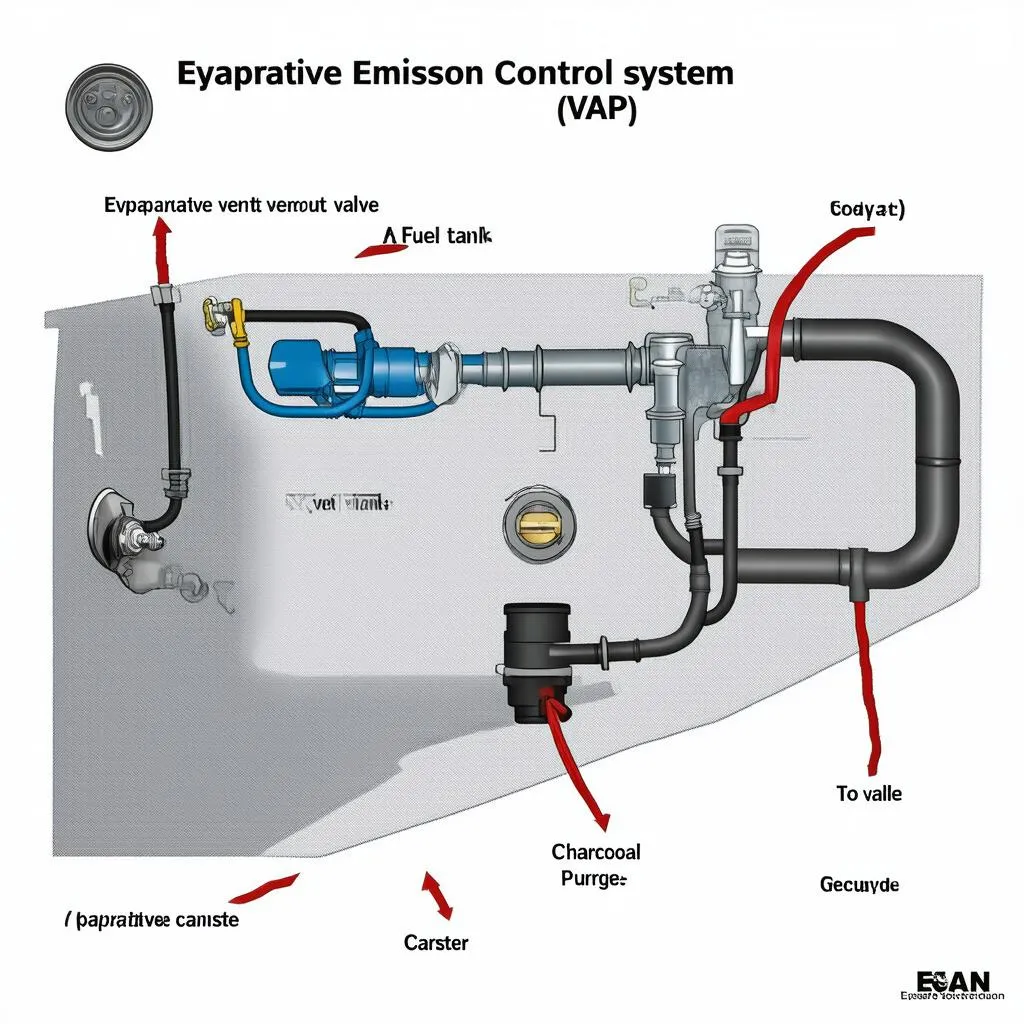Have you ever started your car, only to be greeted by a menacing check engine light? That little beacon of worry often signals trouble, and more often than not, it’s tied to your car’s complex emissions system. One common culprit behind this automotive headache is the dreaded Obd Code P0455.
Picture this: you’re driving down the road, enjoying the scenery, when suddenly, your dashboard lights up like a Christmas tree. You pull over, heart pounding, and wonder what could be wrong. After plugging in your trusty OBD scanner, you’re met with a cryptic message: P0455. What does it mean? What’s broken? And most importantly, how much is this going to cost you?
Don’t panic! This article will decode the mystery of the OBD code P0455, guide you through its potential causes, and equip you with the knowledge to tackle this common car problem head-on.
Understanding Obd Code P0455
In simple terms, the OBD code P0455 indicates a “large leak detected in the evaporative emission control (EVAP) system.” But what does that actually mean for you and your car?
The EVAP system plays a crucial role in reducing harmful fuel vapors from escaping into the atmosphere. Imagine a sealed system within your car that captures these vapors from the fuel tank and lines, preventing them from polluting the air we breathe. The P0455 code means there’s a significant leak somewhere in this system, rendering it less effective at its job.
Think of it like a leaky bucket: instead of containing all the water, some of it escapes through the cracks. Similarly, a leak in your EVAP system allows fuel vapors to escape, which not only harms the environment but can also impact your car’s performance and fuel efficiency.
Common Causes of Obd Code P0455
So, what are the usual suspects behind this pesky code? Here are some common culprits:
- Loose or Damaged Gas Cap: It may seem trivial, but a loose, damaged, or missing gas cap is often the easiest and cheapest fix for a P0455 code.
- Faulty Vent Control Valve: This valve regulates the flow of vapors within the EVAP system, and a malfunction can trigger the code.
- Damaged EVAP Canister Purge Valve: This valve releases stored vapors into the engine for combustion. If it fails, it can disrupt the system’s pressure and trigger the code.
- Leaky EVAP Lines or Hoses: Over time, the hoses and lines connecting various EVAP components can crack, deteriorate, or become disconnected, leading to leaks.
- Damaged Fuel Tank or Filler Neck: While less common, a damaged fuel tank or filler neck can also be the source of a large EVAP leak.
Diagnosing and Fixing the Problem
While the P0455 code provides a general indication of the issue, pinpointing the exact cause requires a bit of automotive detective work. Here’s a possible approach:
- Start with the Obvious: Check your gas cap first. Ensure it’s tightly sealed and undamaged. If you suspect a faulty gas cap, try replacing it with a new one, as they are relatively inexpensive.
- Visual Inspection: Inspect all visible EVAP components, including hoses, lines, and connections, for signs of damage, cracks, or disconnections.
- Smoke Test: A qualified mechanic can perform a smoke test to identify leaks within the EVAP system. This involves injecting harmless smoke into the system and observing where it escapes.
- Component Testing: If a visual inspection and smoke test don’t reveal the culprit, further diagnosis might involve testing individual EVAP components, such as the vent control valve and purge valve.
 EVAP System Diagram
EVAP System Diagram
Obd Code P0455: Beyond the Technicalities
While understanding the technical aspects of the P0455 code is essential, it’s also interesting to consider the potential psychological and financial implications it can have on car owners.
Imagine the frustration of dealing with a persistent check engine light, especially if it impacts your car’s performance or fuel efficiency. The uncertainty surrounding the problem and the potential cost of repairs can cause significant stress and anxiety.
From a financial standpoint, addressing an OBD code P0455 can range from a simple, inexpensive gas cap replacement to a more costly repair involving multiple components.
Expert Insight:
“The cost of diagnosing and repairing a P0455 code can vary greatly depending on the make and model of your vehicle and the severity of the leak,” says James Miller, an ASE-certified master technician and author of “The Complete Guide to Automotive Emissions Systems.” “While a simple gas cap replacement might only set you back $20-30, a more complex repair involving the EVAP canister or fuel tank could cost several hundred dollars or more.”
Frequently Asked Questions about Obd Code P0455
-
Can I still drive my car with a P0455 code?
While driving with a P0455 code might not render your car undrivable, it’s not recommended. Ignoring the issue can lead to further damage to your EVAP system and potentially affect your car’s performance and fuel economy. Moreover, in some regions, driving with a check engine light on, even for an emissions-related issue, can result in failing an emissions test or even receiving a fine. -
How long can I drive with a P0455 code?
There’s no definitive answer to this question, as it depends on the severity of the leak and your car’s overall condition. However, it’s best to address the issue as soon as possible to prevent further damage and potential complications. -
Can I fix the P0455 code myself?
If you’re comfortable with basic car maintenance, you might be able to tackle some of the simpler fixes, such as replacing the gas cap or inspecting visible EVAP components. However, for more complex repairs, it’s always best to consult a qualified mechanic.
 Car Inspection
Car Inspection
Related Questions and Car Models Affected
Here are some additional questions related to OBD code P0455 that car owners often ask:
- What’s the difference between OBD code P0455 and P0442?
Both codes indicate EVAP system leaks, but P0455 signifies a large leak, while P0442 suggests a smaller one. - Can a bad fuel pump cause a P0455 code?
While uncommon, a failing fuel pump can sometimes contribute to EVAP system leaks and trigger a P0455 code. - Will clearing the P0455 code fix the problem?
Clearing the code might temporarily turn off the check engine light, but it won’t address the underlying leak. The code will likely return unless the issue is repaired.
OBD code P0455 can affect a wide range of car makes and models, including but not limited to:
- Ford: F150, Explorer, Escape
- Chevrolet: Silverado, Tahoe, Equinox
- Toyota: Camry, Corolla, RAV4
- Honda: Accord, Civic, CR-V
- Jeep: Grand Cherokee, Wrangler
You can find more information on specific car models and their common OBD codes in our other articles:
Conclusion
Encountering the OBD code P0455 might seem daunting, but armed with the right information, you can confidently tackle this common automotive challenge. Remember, early diagnosis and repair are key to preventing further damage to your car’s emissions system and ensuring its optimal performance.
If you’re facing the dreaded P0455 code or have any other automotive concerns, don’t hesitate to reach out to our team of experts. We’re here to help you get back on the road with confidence and peace of mind.
Need Help? Contact our Automotive Experts 24/7 via Whatsapp: +84767531508
We specialize in diagnostic tools and car repair guidance. Let us help you decode the mystery of your car troubles!